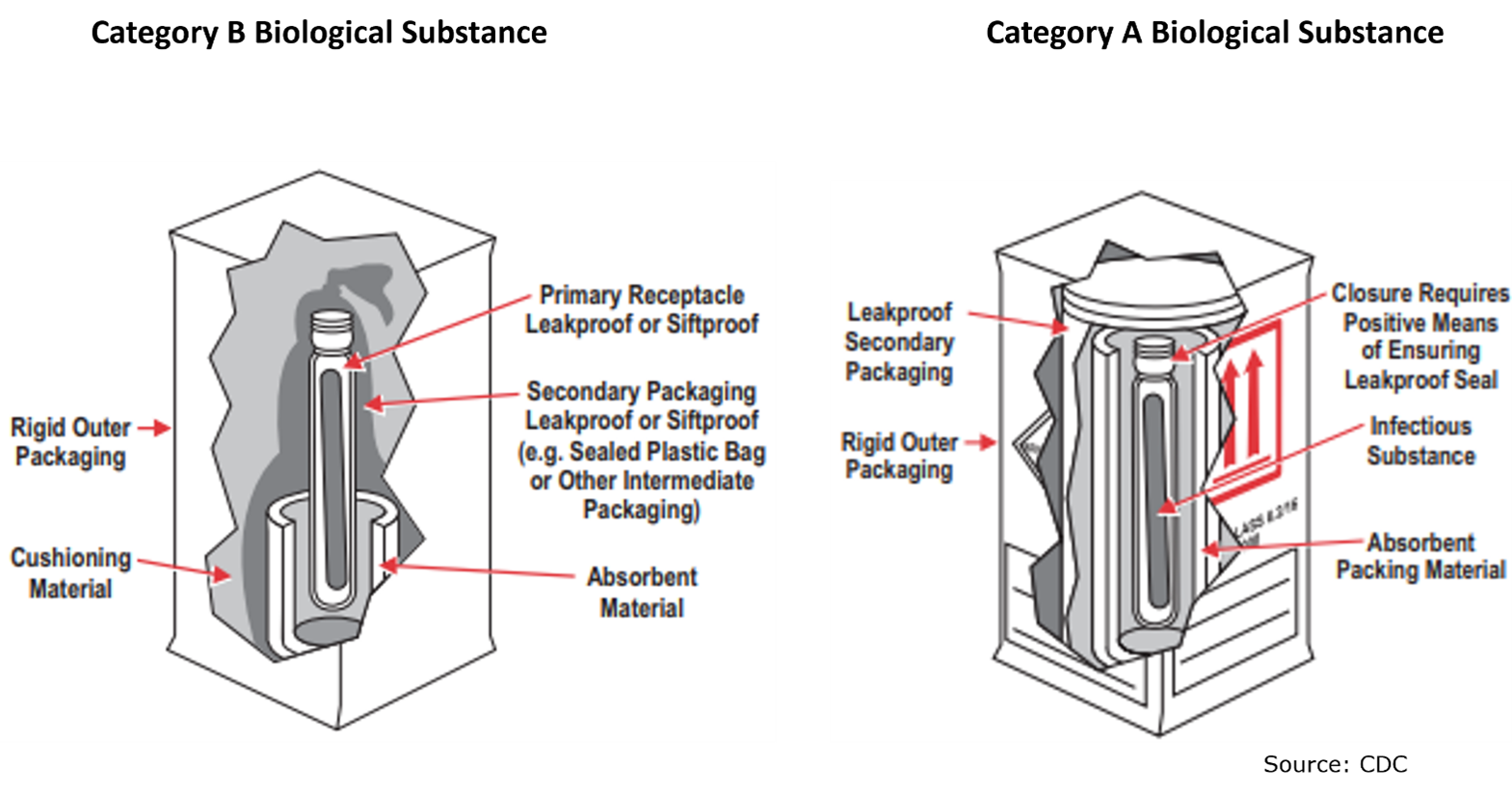Submitting Mycobacterium Specimens to DSHS Laboratory
Quick Links: Specimen Submission Steps | Sputum, Bronchial Washing, and Tracheal Aspirates | Miscellaneous Body Fluids and Tissues | Pure Isolates | AFB Clinical Specimen Preparation and Submission Guidelines | Specimen Labeling Requirements | Required Fields on G-MYCO Submission Forms | G-MYCO Submission Form Tips | Shipping TB and Other Mycobacterial Specimens to the DSHS Laboratory | Shipping Mycobacterial Specimens Safely
Specimen Submission Steps
Refer to the DSHS’ LTSM test menu for specific guidance on specimen types, required volumes, and shipping temperatures for each test. Refer to the DSHS’ online Specimen Collection and Submission Guidance and Specimen Shipping and Mailing Guidance content for additional guidance on submitting clinical specimens to the Lab.
The steps to submitting TB specimens are outlined in the 4-step graphic.

1. Request a DSHS Lab Submitter ID Number
New users and users updating previously submitted information, must fill out every applicable field of a Submitter ID Request Form and email the completed form to labinfo@dshs.texas.gov or fax it to 512-776-7533.
2. Obtain a Specimen Submission Form
Once you have a Submitter ID number, request a master copy of the required G-MYCO specimen submission form from Laboratory Reporting by emailing LabInfo@dshs.tx.gov or calling 512- 776-7578.
A G-MYCO form is required for each mycobacteriology specimen submission.
- Use the most recent version of the G-MYCO form. Using old forms may be missing some required information and cause a specimen to be rejected. Email LabInfo@dshs.tx.gov to order updated forms.
3. Collect and Label Specimen
High-quality specimens are vital for the laboratory diagnosis of TB. All received specimens must be labeled with at least two unique identifiers, preferably three.
NOTE: Patient identifiers on the specimen label and in the submission form must be identical.
- See the section titled Specimen Labeling Requirements for more details on providing matching identifiers on the specimen label and submission form.
- Downloadable guidance for correct specimen labeling is available. These flyers are designed to be printable and quick reference.
Sputum, Bronchial Washing, and Tracheal Aspirates
The Lab accepts sputum, bronchial washings, and tracheal aspirate specimens for smear test, culturing, and Nucleic Acid Amplification Testing (NAAT).
- Sputum specimens are preferably collected under the direction of a trained healthcare professional. Additional guidance on sputum collection may be found in the table below. Use sterile, leak-proof 50 mL conical tubes.
- Minimum volume required for testing is 3mL to 15 mL in each container. Do not overfill.
- Specimens must be submitted to the DSHS Lab as soon as possible after collection, to be tested within 24 hours of collection. If shipping is delayed, refrigerate the specimen.
Miscellaneous Body Fluids and Tissues
A variety of body fluid specimens are accepted for mycolic acid detection by direct HPLC and for identification tests. Body fluids are specimens other than plasma, serum, or urine. They include cerebrospinal fluid (CSF), dialysate, postsurgical drain fluid, wound fluid, and other fluids often obtained using ultrasound-guided aspiration (such as pancreatic, pericardial, and pleural fluid).
- Use sterile, leak-proof container for specimen collection such as a 50 mL conical tube.
- CSF volume required ≥ 1mL.
- Storage and preservation are dependent upon fluid type/origin.
- Specimens must be submitted as soon as possible after collection.
Pure Isolates
Pure isolates may be submitted for drug susceptibility testing on solid culture or in liquid media. Specimens must be pure and actively growing. The Laboratory does not supply isolation media.
- Solid media must contain visible growth of more than one colony.
- Minimal volume of 2 mL for liquid media is required.
- Specimen must not be older than 4–5 weeks.
- M. tuberculosis isolates MUST be shipped as Category A, UN 2814 Infectious Substance affecting humans.
- Unidentified isolates may be shipped as Category B Infectious Substances.
Pure Isolates for CDC Referral
Isolates for CDC referral must first be submitted to the DSHS Austin Laboratory. Providers must not submit mycobacteria directly to CDC.
Questions about CDC referrals? Call the Mycobacteriology Team at 512- 776-7342, or email Mycobacteriology@dshs.texas.gov.
For more information on specimen collection and storage requirements, review the test description of your requested test at the DSHS Lab Testing Service Manual. Acid fast bacilli (AFB) specimen collection and submission guidance is also provided in the table Acid Fast Bacilli Clinical Specimen Collection and Submission Guidelines.
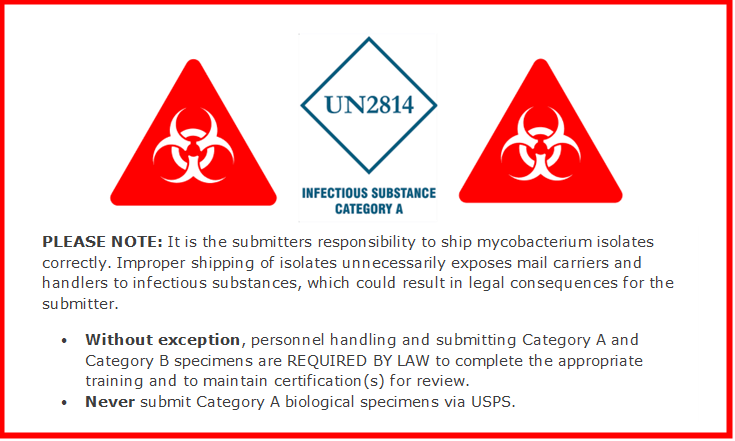
Acid Fast Bacilli Clinical Specimen Preparation and Submission Guidelines
|
Specimen Type |
Required Vol. and Specimen Preparation |
Storage and Shipping |
Replica Limits |
|---|---|---|---|
|
Abscess: General |
2 –3 ml of tissue in sterile saline. Minimum of 1g of tissue. |
Collect in sterile leak-proof container such as a 50 mL conical tube.
|
1/day/source |
|
Abscess: Open |
2 – 3 ml of tissue in sterile saline. Minimum of 1g of tissue. |
Collect in sterile leak-proof container. Do not use culture swabs or transport media. |
1/day/source |
|
Body Fluids: abdominal, amniotic, ascites, bile, joint, paracentesis, pericardial, peritoneal, pleural, synovial, thoracentesis |
2 – 3 ml minimum |
Collect in sterile leak-proof container. |
None |
|
Cellulitis, aspirates |
2 – 3 ml minimum |
Submit in sterile leak-proof container such as a 50 ml conical tube. |
1/day |
|
Cerebrospinal Fluid (CSF) Analysis |
2– 3 ml minimum |
Submit in a sterile leak-proof container. |
None |
|
Endometrial Tissue |
Minimum 1 g of tissue |
Submit in a sterile leak-proof container; if dry, add up to 5 ml sterile saline for transport. |
1/day |
|
Eye: Corneal Scrapings |
n/a
|
Isolate on BHI with 10% sheep blood agar plate (BAP) or chocolate agar plates (CHOC). |
None |
|
Eye Exudate |
Minimum 1 mL preferred |
Submit in a sterile leak-proof container. |
None |
|
Feces/Stool |
1 g minimum, preferably more Pass specimen directly into a sterile leak-proof container. Rectal swabs are not acceptable for mycobacterial culture. |
Submit in a sterile leak-proof container. |
1/day |
|
Gastric Wash or lavage for mycobacteria |
5 – 10mL minimum Neutralize wash within 1 h of collection with 100 mg sodium carbonate since mycobacteria die rapidly in gastric washings. |
Submit in a sterile leak-proof container. |
1/day on three consecutive days |
|
Respiratory: lower bronchoalveolar lavage, brush or wash, endotracheal aspirate, transtracheal aspirate |
3 mL minimum |
Submit in a sterile leak-proof container. |
1/day |
|
Skin Lesion |
Tissue: If tissue is collected, place tissue in sterile leak-proof container and add 2 ̶̶– 3 mL sterile saline for transport. Swabs are discouraged unless it is the only specimen available. |
Submit in a sterile leak-proof container. Swabs submitted in transport medium or culturette tubes are unacceptable. |
1/day |
|
Sputum: Natural |
3 mL minimum |
Submit in a sterile leak-proof container such as a 50 ml conical tube. |
At least three consecutive specimens needed, collected at 8-to-24-hour intervals, with at least one collected in the early morning. |
|
Sputum: Induced |
3 mL minimum Collect in a sterile, leak proof container such as a 50 mL Falcon tube. |
Submit in a sterile leak-proof container such as a 50 ml conical tube. |
At least three consecutive specimens needed, collected at 8-to-24-hour intervals, with at least one collected in the early morning. |
|
Tissue / Lymph Node Biopsy |
As much tissue as possible. |
Submit in a sterile leak-proof container. |
1/day |
|
Vaginal Secretions |
[no volume provided for secretions] Swabs are discouraged unless it is the only specimen available. |
Submit secretions in a sterile leak-proof container. Swabs submitted in transport medium or culturette tubes are unacceptable. |
1/day |
Specimen Labeling Requirements
- Every specimen must have at least two unique patient identifiers affixed to it. Three identifiers are preferred.
- Every specimen must be submitted with a submission form.
- Patient-specific identifiers on the specimen and the submission form must match exactly.
- All required fields in the submission form must be completed.
Specimens not meeting these requirements will be rejected (unsat) by the Laboratory. Potential delays in patient treatment can be avoided with correct specimen labeling and completion of submission forms.
Acceptable specimen identifiers include, but are not limited to:
- Patient’s Name
- Patient’s Date of Birth
- Patient’s Medical Record Number
- Specimen ID Number
- CDC Number
- Unique Random Number
- Medicaid Number
- Date of Collection
Note: Location-based identifiers such as hospital room number or street address are NOT acceptable.

Sample label showing acceptable identifiers
Patient identifiers on label are fictitious. Any similarity to a real person is coincidental.
Required Fields on G-MYCO Specimen Submission Forms
- All required fields in the G-MYCO form are marked with double asterisks (**) and MUST be completed.
- A G-MYCO specimen submission form is required for every mycobacteriology specimen submission.
- If filling out the form by hand, use BLOCK lettering. To improve legibility and reduce transcription errors avoid using cursive script.
- A submission form is required with every specimen.
- Do not bundle a submission form with two or more specimens.
- Do not place labels or stickers over any required fields.
Required Fields on G-MYCO Submission Form, Explained
| Submitter’s Texas Provider Identifier (TPI) Number SECTION 1 |
The TPI number is a unique number the DSHS Laboratory assigns to each of our submitters. To obtain a Texas Provider Identifier (TPI) number, contact Texas Medicaid and Healthcare Partnership (TMHP) at 1-800-925-9126. To request a DSHS submitter number, a master form, or to update submitter information, call (888) 963-7111 ext. 7578 or 512- 776-7578, or fax 512- 776-7533. Alternatively, visit DSHS Forms and Laboratory Fee Schedule |
|---|---|
| Submitter’s National Provider Identification (NPI) Number SECTION 1 |
All health care providers must include their NPI number. To obtain an NPI number, contact the National Plan and Provider Enumeration System (NPPES) toll free at (800) 465-3203 or via their website at https://nppes.cms.hhs.gov/NPPES/Welcome.do |
| Submitting Facility’s Name and Address SECTION 1 |
Provide the submitter’s name, address, City, State, and zip code. Clearly print, use a pre-printed label, or use a legible photocopy of a master form provided by DSHS Laboratory. |
| Submitting Facility’s Point of Contact Information | Provide the name, telephone number, and fax number of the point of contact (POC) at the submitting facility in case the laboratory needs additional information about the specimen or isolate. |
| SECTION 1 | |
| Clinic Code SECTION 1 |
Provide only when applicable. The clinic code identifies the satellite office that submitted the specimen to the submitter. It helps the submitter identify where the lab report belongs in situations when the submitter has a primary mailing address with satellite offices. |
| Patient Information SECTION 2 |
Complete ALL required fields in this section. The patient’s first and last name provided on the specimen MUST match the patient’s name on this form. All specimens MUST be labeled with at least two patient-specific identifiers; both a primary and a secondary identifier. The identifiers used MUST appear on both the specimen container and its submission form. Specimens that do not meet these identifier requirements will be classified as unsatisfactory for testing and will not be tested. |
| Specimen Source or Type SECTION 3 |
Indicate the type of material or the source of the specimen or isolate being submitted. For specimens not described in the list, check the “Other” option, provide specific details, and initial next to them. |
| Clinical Specimens: Test Requested SECTION 4 |
Identify the test requested for the clinical specimen being submitted. Tests are groups by specimen type: Raw Unprocessed, Processed Sediments, and AFB Positive Smears. Note: Prior authorization is required for submission of AFB positive smears. To cancel a test marked in error, place a single line through the test name and write “error”. Provide information about any previous laboratory testing of this specimen to assist DSHS with the identification process. |
| Referred Pure Cultures: Test Requested SECTION 5 |
Identify the test requested for the isolate being submitted. To cancel a test marked in error, place a single line through the test name and write “error”. Provide information about any previous laboratory testing of this specimen to assist DSHS with the identification process. |
| Ordering Physician’s Information SECTION 6 |
Provide the name of the physician who ordered the test and the physician’s NPI number. |
| Payor Source SECTION 7 |
Select TB Elimination (1619) as the Payor. |
| Susceptibility Testing SECTION 8 |
Check “Yes” or “No” to indicate whether the specimen is of suspected Multiple Drug Resistant M. tuberculosis. Indicate which Drug Susceptibility Panel is being requested, for either M. tuberculosis (MTB), or M. kansasii. |
- All required information on a submission forms is marked with double asterisks (**).
- A submission form is required with every specimen.
- Do not bundle a submission form with two or more specimens.
- Do not place labels or stickers over any required fields.
Submission Form Questions? Contact the Laboratory Reporting Group at 1-888-963-7111 ext. 7578 or email: LabInfo@dshs.texas.gov.
G-MYCO Submission Form Tips
Several TB specimens received at the Laboratory require follow up calls to submitters because they are missing required information or identifiers. The following are tips to avoid the most common submission form issues.
Specimen Label and Submission Forms Must Agree
- Patient identifiers provided on label and in Sections 2 and 3 of submission form must match exactly.
- The patient identifiers on specimen labels must also be put in the submission form. Abbreviating or obscuring patient name(s) on specimen labels is discouraged.
- The Date of Collection (DOC), MUST be provided.
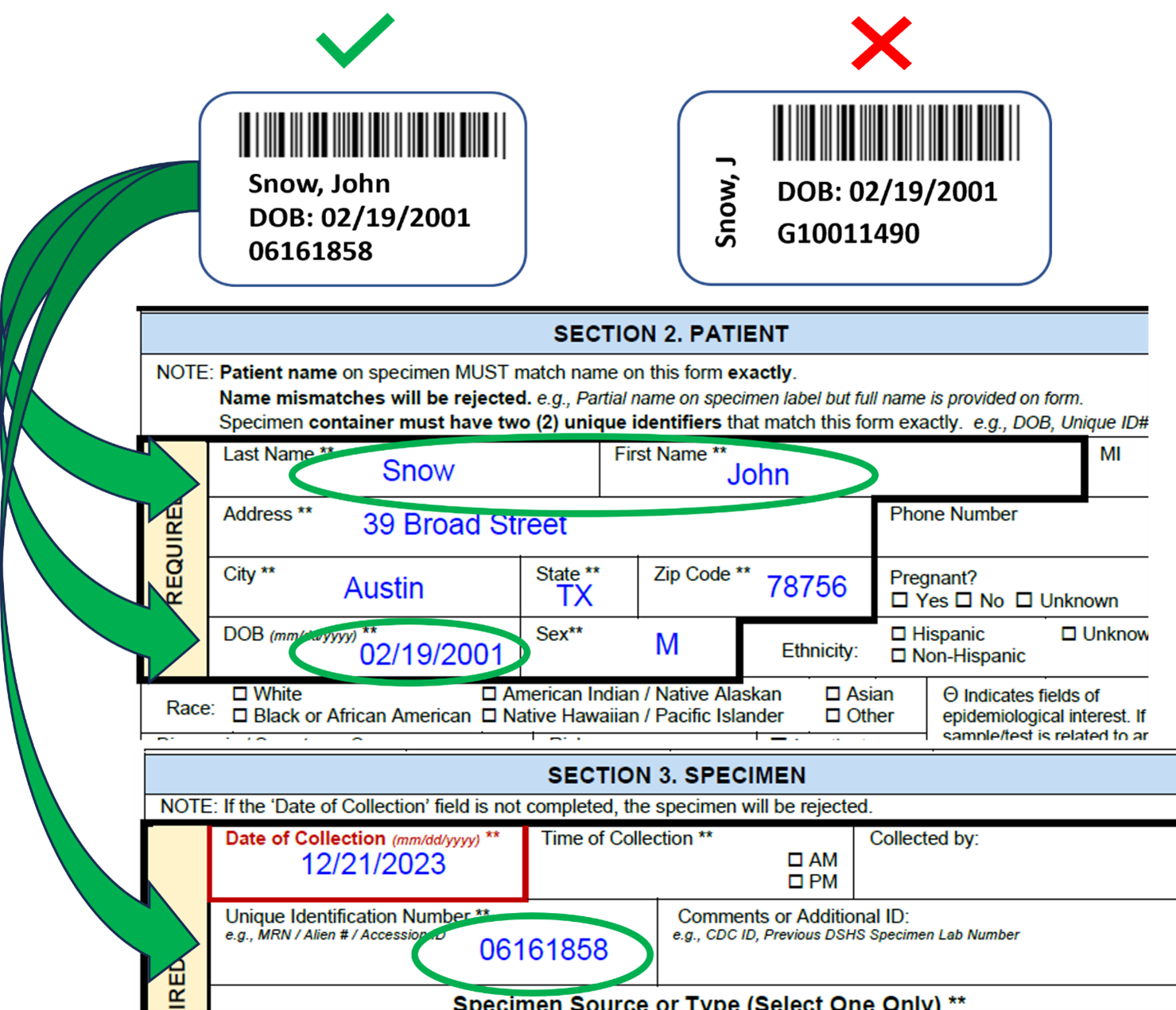
Section 3: Specimen Source Must be Identified
Identify only one specimen source.
- Indicate the specimen source by checking only one option in Section 3.
- Avoid accidentally checking two boxes.

Sections 4 and 5: Request a Test
- Identify the type of test requested by checking only one option in Section 4. DSHS Laboratory.
- Only one test should be selected.
- Ensure the test requested is appropriate for the specimen.
- Specimens cannot be processed without a test being selected.

Section 7: Identify the TB Elimination Program as the Payor
- Select “TB Elimination”.
- If Section 7 is left blank, the submitter is automatically charged.
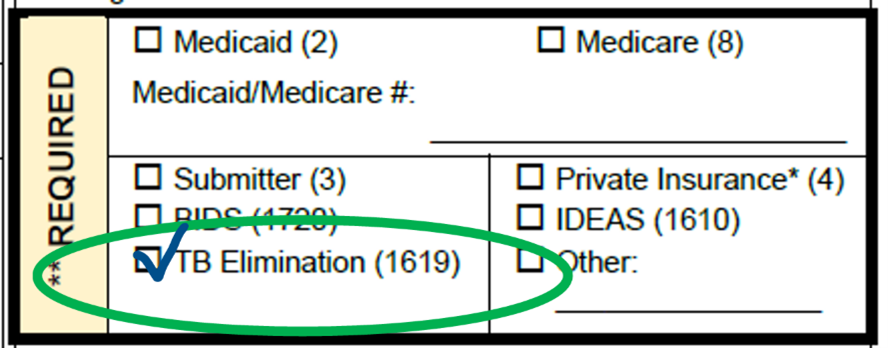
4. Shipping TB and Other Mycobacterial Specimens to the DSHS Laboratory
Mycobacterial specimen submissions are classified as infectious substances and must be packed and shipped accordingly. Submitters have legal responsibilities for the safe handling, labeling, and shipping of mycobacterial specimens.
| Specimen Type | Infectious Substances Classification |
|---|---|
| Clinical Specimens | Category B Infectious Substance, UN3373 |
| Unidentified Isolates | Category B Infectious Substance, UN3373 |
| M. tuberculosis and Suspected M. tuberculosis Isolates | Category A, UN2814 Infectious Substance Affecting Humans |
Before shipping your specimens, make sure you
- labeled the specimen with the required patient identifiers (two minimum, three preferred),
- secured the lid of specimen container to prevent leaks,
- completed a G-MYCO specimen submission form for each specimen,
- provided the date of collection on the submission form,
- selected the requested test on the form,
- attached copies of any previous lab results,
- triple packed the specimen according to its classification,
- secured specimen inside shipping container to prevent breaks,
- affixed all required shipping labels to the outer mailer, and
- packed with frozen gel packs, not dry ice with chilled specimens.
Also refer to the shipping directions in the LTSM test pages found in the LTSM Test Menu for test-specific details.
Temperature Requirements for AFB and TB Specimens
| Specimen Type | Shipping/Storage Temperature | Other Requirements |
|---|---|---|
| Sputum, Bronchial Washing, and Tracheal Aspirate | Cold (2–8°C) |
|
| Miscellaneous Bodily Fluids | Cold (2–8°C) |
|
| Isolates | Ambient |
|
Shipping Mycobacterial Specimens Safely

Submitters are legally responsible for the safe handling, labeling, and shipping of infectious substances to the DSHS Laboratory.
Without exception, anyone handling or shipping Category A or Category B specimens is required to complete the appropriate training on handling and shipping of hazardous materials and to maintain their certification(s) for review. See 49 CFR § 172.700, 49 CFR § 172.702, and 49 CFR § 172.704.
Failure to be trained and to properly pack and ship infectious substances materials is a violation of federal law and each person who knowingly violates a requirement of the law is liable for a civil penalty (fines).
NOTE: The DSHS Laboratory does not provide, nor is it responsible for ensuring submitters complete the required training. The shipping information presented here is not a substitute for completing shipping hazardous materials training required to comply with Federal Hazardous Materials Transportation law.
| Mycobacterial Specimen Type | Classification | Outer Mailer Labeling Requirements |
|---|---|---|
| Clinical (e.g., swabs, stool, urine, sputum, gastric lavage, biopsy tissue) | Category B Infectious Substances, UN3373 | 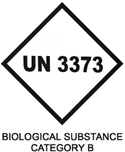 |
| Pure Isolate (liquid or solid media) | Category A Infectious Substances, UN2814 Infectious Substance affecting humans | 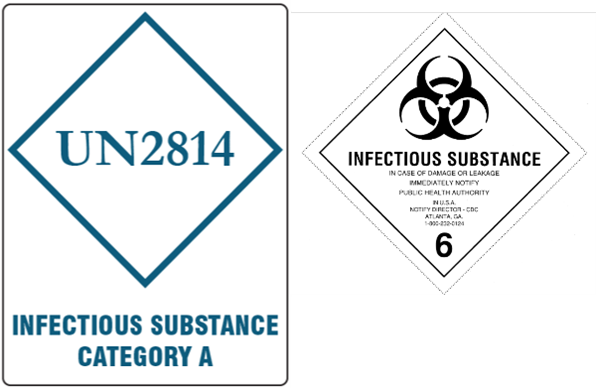 |
Wrap Primary Containers Individually Multiple fragile primary containers must be individually wrapped in absorbent material or separated to prevent contact between them.
- Ideally, each primary container should be sealed in its own secondary container with enough absorbent material to soak up all of specimen should it spill.
